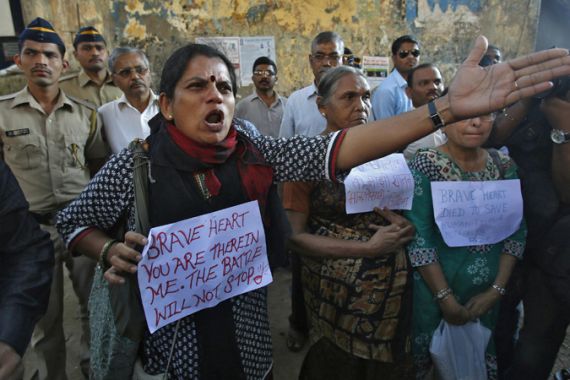Patriarchy: A losing battle in India?
As growing number of women get education and join work force, the shackle of patriarchy is slowly loosening up.

On the day that death penalty was sentenced to the four men who raped and murdered a student in Delhi in December 2012, a Bollywood movie was released, whose poster had its leading ladies with their descending necklines holding a sausage, a banana, and an uncorked champagne bottle.
So far, the movie, “Grand Masti”, has already crossed the Rs 100 crore mark. Equally absurd is a new rape statistic: that the span of time for a rape to be reported has gone down to every 22 minutes than the previous 20 minutes.
Keep reading
list of 4 itemsInside the pressures facing Quebec’s billion-dollar maple syrup industry
‘Accepted in both [worlds]’: Indonesia’s Chinese Muslims prepare for Eid
Photos: Mexico, US, Canada mesmerised by rare total solar eclipse
Does the shift of two minutes imply more liberated women, and thereby women having control over personal and public space, and thus, her movements? Half of the country’s population has to strife each day to claim that she is a human being.
But women aren’t exactly half the population of India. For every 1,000 boys under the age of six, there are only 914 girls. Girls are either killed in the womb, or the newborn is gagged, asphyxiated or poisoned. Often, it is the mother, still raw from her delivery, who has to eliminate every trace of a daughter.
Women are objectified on the big screen (and they don't seem to mind those roles), while women at home are reminded constantly of the powerlessness that is their gender.
Here is where women are objectified on the big screen (and they don’t seem to mind those roles); here is where women are constantly reminded of the powerlessness that is their gender, in subtle or pounding thuds.
Often, this rebuttal of one’s ownership of identity come from women themselves: patriarchy digs its unsettling burrows deep.
The restrictions of going out, to begin with, are based on the premise that “out” is threatening. So the home is seen as the safe haven; it is also the primary school for patriarchy.
“Women are given the crown of being the ‘ruler’ at home, which has a very functional basis,” says filmmaker Rahul Roy, who has initiated a project titled “Let’s Talk Men” to include the experiences of men in the broad conversations of gender.
But women do step out – they might wear the veil, but they step out to go to the market. In slums, women step out to claim the daily water at a public tap, at 4am. Shalini Nagar, a 55-year-old mother of four, and grandmother of two, says she does not feel empowered because her husband wouldn’t let her step outside the house.
Yet, she is the one taking her ailing daughter-in-law to the hospital. Malls – the new symbol of a globalised India – are the new sites where girls hang out in groups. Slowly, the ceiling is being pushed upwards. In the last two decades, more women are forced to go to work. They are becoming primary breadwinners, and men fear losing the decision-making powers at home.
But is every woman comfortable “outside”? The number of coaches in the suburban railway system in Mumbai, meant to be safe passageways for the city’s women, have been increased from two to three; the first class ladies coaches have gone from one to two.
Yet, as filmmaker Paromita Vohra puts it, “These coaches have failed to integrate women into a wider space. The men’s coaches are still seen as unsafe spaces.”
Vohra explored the complexity of space, gender, class and caste when she turned her camera to public toilets in India. “The municipal laws state that the number of toilets for women vis-a-vis men should be in the ratio 2:3. “There is already a lower expectation that is based on an assumption of fewer number of women,” she says.
The assumption of fewer women out there translates into an assumption of their incompetence. Female photographers are continuously undermined by male photographers.
Women drivers are assumed to be traffic disasters. Women who have reached the boardrooms have to subtly, swiftly, retort back when assumptions of her lack of business acumen begin to buzz.
But gender roles are changing, possibly making space for women. In the corporate world, more men are going home on Friday nights, like their female colleagues, to spend time with their family, rather than networking at a party. But are institutions in the public sphere open to accommodating these changing gender roles?
A case in point is the delivery of courier packages, and the expectation of someone at home to fetch the package.
“Men and women are both working today. But there is an inherent assumption that someone – mostly women – will be at home to receive the packages,” observes Vohra.
In this complex web of women stepping out to chase a little dream, or to bring the daily bread and the occasional pizza home; of women bargaining for the best price of vegetables from their doorsteps; of women leading the boardroom bids; of stay-at-home women entrepreneurs who cook food for scores of office-goers (which is ferried to the destination by the dabbawallahs)… there is a slow simmering of thousands of mutinies.
The public space has a long way to go to make it conducive for everyone – men, women, the disabled. But Roy sums up best: “Change is unstoppable, and it is evident everywhere, in small ways. Patriarchy is a losing battle today.”
